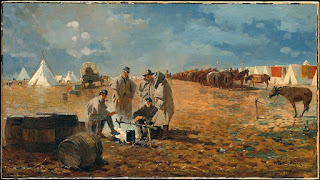When you first think of Winslow Homer, you probably picture one of his famous landscape paintings or watercolors, perhaps one picturing the sea. As one of the most famous 19th-century American landscape painters, many of his works depict landscapes and simple scenes from everyday life. And although the paintings in this exhibition do fall into this category, there is much more to Homer as an artist and how he went about his work than this. Many of these paintings that seem at first glance to be quite simple, at least in terms of subject matter, in fact contain nuggets of symbolism and deeper meanings. Homer frequently references the culture and history at the time in subtle ways, allowing the viewer to put himself into the shoes of people who lived in that time period and cultural moment. Having traveled with the Union army during the Civil War, he painted many war images, and his scenes of everyday life often point to the ways that life had changed because of the war. This exhibition explores Homer’s work through pieces like these, giving examples of both landscape paintings and scenes from daily life that contain deeper meanings on top of the aesthetically beautiful work.
Friday, April 22, 2022
Deeper Meanings in Winslow Homer's Paintings
The Veteran in a New Field, Winslow Homer
1865
oil on canvas, 24 1/8 x 38 1/8 in
MET: 67.187.131
The Veteran in a New Field is a simple landscape painting that is full of symbolism that adds deeper meaning to the piece. Even though it is a simple painting, depicting a lone man in the middle of a field, it is full of civil war imagery, evoking ideas of life and death, war and peace. Homer uses these ideas to allow the viewer to step into this time and imagine how it must feel to live through the horrors of war and death come out into a time of new life.
Dressing for the Carnival, Winslow Homer
1877
oil on canvas, 20 x 30 in
MET: 22.220
Dressing for the Carnival shows African American women and children who have, as the title suggests, dressed up for a carnival. Another piece that was painted after the Civil War, this painting evokes the endurance and suffering of African Americans during that time. Although they were freed from slavery after the Civil War, but they are still far from experiencing the same freedom as white Americans. Homer invites the viewer into this space too, allowing us to imagine both the hope and pain that these women and their families experienced.
The Gulf Stream, Winslow Homer
1899, reworked in 1906
oil on canvas, 28 1/8 x 49 1/8 in
MET: 06.1234
The Gulf Stream is a dramatic landscape painting, depicting a man on a boat in the middle of the ocean. One of Homer’s less subtle paintings, the man is surrounded by sharks on a broken-down fishing boat. Suggesting this man’s imminent death, this painting points to ideas of the mortality and vulnerability of man. It forces the viewer to face sorrow and death while also still providing us with a hope that the man does not seem to see—the boat on the horizon. This painting allows the viewer to step into the scene by feeling these emotions with the figure.
Snap the Whip, Winslow Homer
1872
oil on canvas, 12 x 20 in
MET: 50.41
Snap the Whip is another of Homer’s famous paintings, which at first glance simply depicts a scene of everyday life—schoolboys playing together in a field. However, taking into account the time period, it is clear that Homer is getting at something deeper than that. Coming out of the Civil War back into everyday life, we see evidences of the poverty that has followed the war in the children’s clothes. And although we see Homer’s optimism in the playfulness of the image, we also get this sense that these children, as shown by the boy on the end of the line, will face challenges growing up in this time. The painting invites the viewer to experience this nostalgia and imagine how it would be to grow up in a world fresh out of war.
Rainy Day in Camp, Winslow Homer
1871
oil on canvas, 20 x 36 in
MET: 23.77.1
Rainy Day in Camp is one of Homer’s war paintings which depicts a scene from his time as a traveling artist during the war. Several men are gathered around a fire with their camp in the background—rows of tents and horses give us an idea of the number of men who are not pictured here, but who were there, sacrificing themselves for their country. Painted several years after the end of the war, and now looking at it hundreds of years later, the simple scene again allows the viewer to insert himself into that time, imagining the trials and sufferings that these men went through for their country.
Inside the Bar, Winslow Homer
1883
watercolor and graphite on off-white wove paper, 16 x 29 in
MET: 54.183
Inside the Bar is another of Homer’s landscape paintings depicting the sea. This painting shows a woman from Cullercoats, a village on the North Sea where Homer stayed for part of a year. Many artists were attracted to this place because of how picturesque the land was, but Homer wanted to tell a deeper story. In this piece, he paints a woman with a basket on the edge of the water, nodding to the role of the women in this community—those who would work hard at home while waiting for the men to return from the sea. He invites the viewer to look past the beauty of the place and to the beauty and courage of the people living there.
Subscribe to:
Post Comments (Atom)






No comments:
Post a Comment